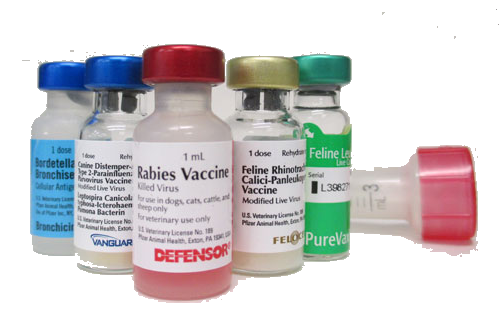| Bovine Herpesvirus 1:- Inactivated and attenuated-live vaccines for infectious bovine rhinotracheitis and infectious pustular vulvovaginitis are available. Vaccines may not prevent infection but reduce clinical signs and significantly reduce shedding of field virus. Use of the inactivated vaccine in exotic hoofstock may be preferred, because abortions and initiation of disease in vaccinated hoofstock have not been adequately studied. |
Canine Distemper:- Most, if not all of the Carnivora, including canids, procyonids, mustelids, and the viverrids, are considered susceptible to canine distemper virus (CDV); the susceptibility of most Ursidae and Hyenidae is unknown. Giant and red pandas are an important exception among the ursids and appear quite susceptible; canine distemper vaccination has been specifically evaluated in and is recommended for use in this species.
|
Canine Parvovirus and Feline Panleukopenia:- Canine parvovirus, raccoon parvovirus, and feline panleukopenia virus are closely related antigenically and pathogenetically. Canidae, Felidae, most Mustelidae, Procyonidae, and Viverridae are considered susceptible to one or more of these parvoviruses. Binturongs are susceptible to feline panleukopenia, and vaccination is recommended
|
|
Equine Encephalomyelitis:- Because nondomestic equids are susceptible to equine encephalomyelitis, vaccination should follow guidelines for domestic equids in endemic areas. Inactivated trivalent (Eastern, Western, Venezuelan) or bivalent (Eastern, Western) vaccine, or a combination of these with tetanus toxoid, are administered according to manufacturer instructions. Initial immunization is two doses, 1–2 wk apart with annual revaccination.
|
Equine Herpesvirus 1 Infection:- Equine herpesvirus 1 (EHV-1) can cause abortion in exotic equids; killed virus vaccination is recommended, because adequacy of attenuation in MLV vaccines is unknown for nontarget species. Vaccination of foals should begin at 4 mo, with boosters at 4-mo intervals up to 1 yr. Mares must be vaccinated often to provide protection from abortion, because EHV-1 natural protective immunity after infection lasts only 4 months
|
Erysipelas:- The bacterium Erysipelothrix rhusiopathiae is pathogenic for the Tayassuidae, nondomestic Suidae, cetaceans, and pinnepeds. Erysipelas bacterin can be administered with the standard regimen to nondomestic swine and peccaries (see Erysipelas). Despite the importance of preventing erysipelas in marine mammals, there is no bacterin designed specifically for these animals. Vaccination of cetaceans and pinnepeds is controversial, but a subunit vaccine has been investigated in dolphins (see also Bacterial Diseases of Marine Mammals).
|
|
Feline Caliciviruses:- Exotic felids are susceptible to feline caliciviruses, and some strains may cause serious morbidity and mortality. This is considered a core vaccine in exotic felids. Vaccines are often combined into a multivalent formulation, and vaccine regimens are as for feline rhinotracheitis. |
Feline Herpesvirus Rhinotracheitis:- Feline viral rhinotracheitis is a serious disease threat in exotic Felidae and is considered a core vaccine. Available vaccines, inactivated, subunit, and MLV, are combined with feline calicivirus and are usually in multivalent formulations with other pathogens (eg, feline panleukopenia).
|
Canine Influenza Virus:- Canine influenza virus vaccination for domestic carnivores is considered noncore. However, if a collection has a history of canine influenza or is located in an endemic area, vaccination may be considered. Vaccination may also be considered for great apes, as well as for contact staff on a yearly basis before flu season. Equine influenza vaccine is administered to nondomestic equids in some zoos.
|
|
Infectious Canine Hepatitis (Canine Adenovirus 1):- All Canidae and binturong, a viverrid, are susceptible; Ursidae may also be susceptible. In foxes, the disease is called fox encephalitis due to a predominant neurotropism and neurologic signs. Canine adenovirus (CAV) is a core vaccination for captive canids. Because a killed vaccine is not commercially available, multivalent MLV vaccines containing canine distemper and CAV-1 or CAV-2 are often administered. Based on the close antigenic relationship of CAV-1 and CAV-2, vaccination with either virus provides cross-protection.
|
Leptospirosis:- Leptospirosis occurs sporadically in exotic Canidae, Procyonidae, Viverridae, Ursidae, Mustelidae, Suidae, primates, Tayassuidae, and in Cervidae and other ruminants of the families Bovidae, Artiodactyla, Perisodactyla, Proboscidae, Camelidae, Giraffidae, etc. Vaccination of domestic carnivores with Leptospira bacterins is considered noncore. However, if a collection has a history of or is in an endemic area for leptospirosis, vaccination should be considered with bacterins that contain immunogens against Leptospira interrogans serovars Canicola and Icterohaemorrhagiae.
|
Parainfluenza 3:- Exotic sheep and goats are susceptible to pneumonia caused by parainfluenza 3 (PI-3) and Mannheimia haemolytica. Modified-live virus PI-3 vaccines, particularly those administered intranasally are useful to reduce the incidence of pneumonia in lambs. Vaccine is administered at 3–4 mo of age, 1 mL per nostril, and repeated 3–4 wk before anticipated shipment and annually thereafter.
|
